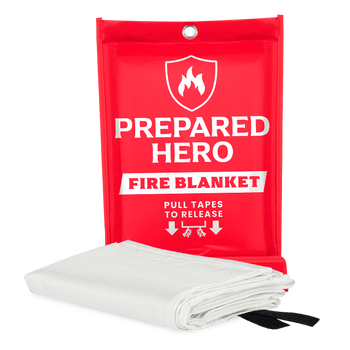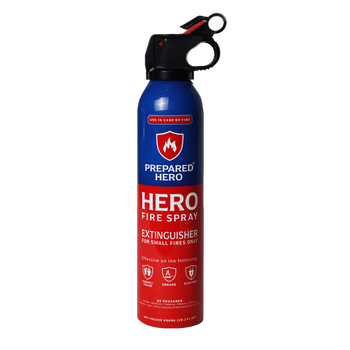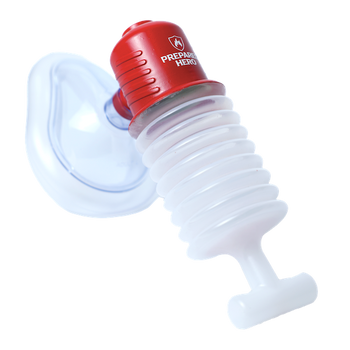Where you put your smoke detectors matters just as much as installing them. Proper placement makes sure they can detect...
Cleaning up after using a fire extinguisher can put you at risk, so you have to protect yourself. If you are faced with the daunting task of cleaning up the chemicals released, we got your back. This guide will walk you through how to clean up after using a fire extinguisher.
How to Properly Clean Up After Using a Fire Extinguisher
Here’s how you can safely clean up the residue left by fire extinguishers, depending on the type you used:
Know the Type of Residue You’re Working With
While fire extinguishers look alike, there are many types of fire extinguishers. They contain different chemicals based on the types of fire they’re meant to put out.
Different chemicals call for different cleanup methods and safety guidelines. So, you have to know what kind of residue you’re working with.
To know what residue you’re working with, check the fire extinguisher’s label or tag. You can also check this guide to know what type of fire extinguisher you have.
Protective Equipment Required
Here are the protective equipment you need to clean up after using a fire extinguisher:
- Mask
- Gloves
- Goggles
Make sure to wear them before cleaning up fire extinguisher residue.
How to Clean Up After Using a Dry Chemical Extinguisher

Dry chemical extinguishers are the most common because they can put out class A, B, and C fires. They’re commonly used in industrial, commercial, and residential buildings.
They contain chemicals like sodium bicarbonate, monoammonium phosphate, and potassium bicarbonate. These chemicals leave a corrosive powder that can damage electronics and metal surfaces, so you must act fast.
Follow these steps to clean up the affected areas after using a dry chemical extinguisher:
- Sweep or vacuum as much of the residue as possible.
- Create a solution with 50% warm water and 50% isopropyl alcohol.
- Spray the affected area to break up the silicone.
- Let the solution sit for approximately five minutes, then rinse it with warm water.
- To clean up the residue with sodium bicarbonate and potassium bicarbonate, mix a solution containing 2% vinegar and 98% hot water.
- Wash the area with it. Allow the solution to set for about five minutes.
- Rinse the area using warm water.
How to Clean Up After Using a Wet Chemical Extinguisher

Wet chemical extinguishers are ideal for putting out grease fires. They’re often used in commercial kitchens and restaurants. Follow these steps to clean up the affected area after using a wet chemical extinguisher:
- Turn off all heat and fuel sources connected to your cooking equipment.
- Put enough liquid soap in hot water until it’s foamy or bubbly.
- Scrub the affected area using a rag or sponge.
- Rinse the surfaces and affected areas.
- Let the area dry.
- If the fire was huge, ask a professional to check your cooking equipment before using them.
How to Clean Up After Using a Dry Powder Extinguisher

Dry powder extinguishers put out class D fires that involve metals. They’re often used in factories and warehouses. Follow these steps to clean up the affected areas after using a dry powder extinguisher:
- Vacuum, brush, or sweep the powder residue.
- Put the powder into a plastic bag and seal it.
- Throw away the bag.
- Use a damp cloth to clean the surface.
Be Careful
Chris Judd, a retired fire captain said that dry chemical extinguishing agents are known to be an irritant. That said, he would not want to be exposed to it, if not necessary.
“When I was in the military, they told us that aqueous film forming foam (AFFF) extinguishing agent was perfectly safe and now look at all the lawsuit solicitations and information you see on media about that. The Prepared Hero's Emergency Fire Blanket is way better, in that regard also,” Chris added.
In particular, over-exposure to dry chemical extinguishing agents can cause mild skin irritation, moderate eye irritation, and possible gastric distress. Inhaling the agents may also cause mild irritation of the nose, throat, and other respiratory tissues. In addition, contact with the eyes may cause moderate irritation, reddening of the affected eye, and discomfort.
Conclusion
Knowing how to clean up after using a fire extinguisher ensures your house or workplace stays safe. It also ensures that people’s health won’t be at risk.
Are you looking for an alternative to toxic fire extinguishers that leave a lot of mess? Check out the Hero Fire Spray and Hero Fire Blanket now! They’re non-toxic, NSF-certified, and don’t leave much residue for you to clean up.


 Fire
Fire Safety
Safety Survival
Survival Protection
Protection New
New
 Fire
Fire Safety
Safety Survival
Survival Protection
Protection New
New












